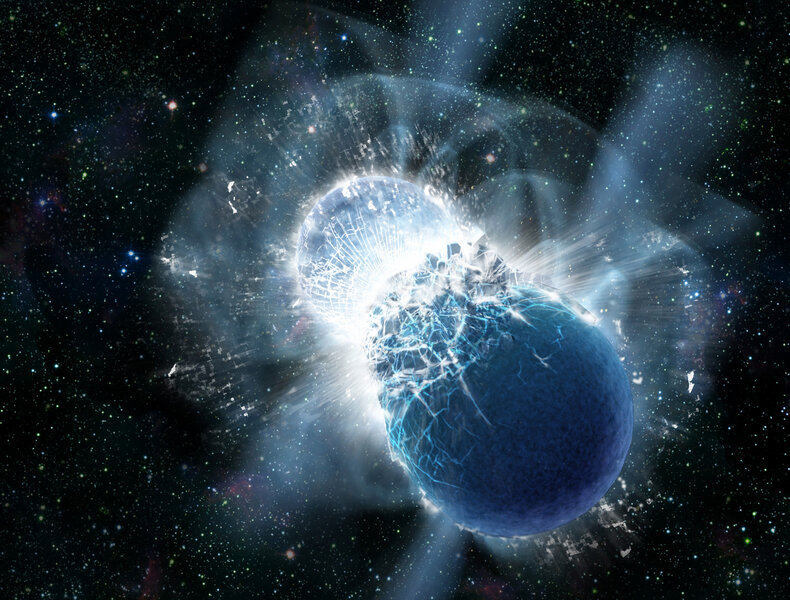Create a free profile to get unlimited access to exclusive videos, sweepstakes, and more!
Last year, two merging neutron stars rocked astronomy. Now it looks like they left behind a black hole.
In August 2017, a huge breakthrough in astronomy was made by a whisper of an event.
130 million light-years away, a binary neutron star system — two super-dense neutron stars orbiting one another — in the galaxy NGC 4993 spiraled in together and merged. This event, dubbed GW 170817 (for the Gravitational Wave event that happened on 17 August 2017) triggered a massive catastrophe: It literally shook the fabric of spacetime, and sent out ripples in reality called gravitational waves (hence the event's name) moving away at the speed of light. By the time they reached us here on Earth they were incredibly faint, but still detectable by LIGO, the Laser Interferometry Gravitational-Wave Observatory.
This was the first neutron star merger event ever detected, and it was a revolution. It was observed across the electromagnetic spectrum, and with the host galaxy pinpointed a distance to the event was found, allowing for even more interesting characteristics to be determined. Astronomers will be digging into this gift from the heavens for a long time to come.
I wrote all about this merger when it was announced, and you can get all the background info there.
But there's a big question that’s been lingering since it happened: What was left behind?
At the time I assumed it was a black hole, which is what you expect from two neutron stars crashing into each other. However, that turns out not to be clear. Usually, black holes form when a massive star goes supernova. The core collapses, and if it has enough mass — about 2.8 times the mass of the Sun, which is a lot — poof. It forms a black hole.
When two neutron stars merge, if the final product's mass adds up to more than this number, it'll form a black hole as well (the critical mass comes from combing the physics of gravity and the quantum mechanics governing how the subatomic particles making up the object behave).
What's so very interesting is that by analyzing the gravitational waves from this merger, the mass of the resulting object is 2.74 times the mass of the Sun — right on the thin edge of forming a black hole. Mind you, the 2.8 solar mass number is a bit flexible; it can depend on other factors, so it's possible to get a black hole with less mass.
So it wasn't clear if whatever was left over from this event was the most massive neutron star ever found, or the lowest mass black hole ever found. Either is pretty cool, but it would be nice to know which.
New research using observations from the Chandra X-Ray Observatory have possibly tipped the balance: The astronomers who did the work think the object is actually a black hole.
Their reasoning is that if a really hefty neutron star had been left over from the merger, it would be spinning very rapidly (that's called conservation of angular momentum, and is similar to an ice skater speeding up their spin as they draw their arms in), and would have a hellaciously strong magnetic field. And I do mean hellacious; it would have to be a trillion times stronger than the Earth's magnetic field! As the neutron star spun, the magnetic field would sweep up particles around the star and accelerate them to nearly the speed of light, flinging them away at ridiculously high speeds (like a dog shaking to get water off, but if the dog weighed a couple of octillion tons, spun thousands of times per second, and the water shot away at just under a billion kilometers per hour).
This blast of particles is called a pulsar wind, and as the particles slam into the material around them they'd generate a ferocious glow of X-rays. However, while the Chandra observations do indicate the presence of X-rays, they are far too weak to be from a pulsar wind. That's strong evidence no neutron star was left over.
Also, much of the X-ray emission was delayed by days and weeks after the event, and that's likely coming from pre-existing material many billions of kilometers or more away. The shock wave generated from the merger would have slammed into that material, heated the matter up, and as a result it would glow in X-rays on its own. The delay was caused by the time it took the shock wave to reach this material, and for it to react.
The flip side of this is that if the merger created a black hole, you wouldn't see strong X-rays because black holes don't work like neutron stars. They don't generate a pulsar wind, so the X-ray brightness would be far fainter. And since the X-rays are pretty faint, a black hole is the likely result.
However, this isn't yet confirmed. It's possible that, if a neutron stars resulted and if a pulsar wind is being made, it’s just taking longer to flow out and strike the material surrounding the event than first thought. If that’s the case, then over the next year or two the spot of the event will brighten in X-rays, and that should be detectable by Chandra. If that doesn't happen, then it's safe to assume a lightweight black hole was born on that day in August 2017.
And that's pretty awesome. But I also have to say, if the brightening occurs, that would be very interesting as well. This would be a big challenge to how we think neutron stars behave, so theoreticians would have to go back to their equations and figure this out.
Either way, it's a win for astronomy. We learned something really amazing. And that's on top of all the phenomenal things we've already learned from this singular event.
… but it won't be singular for long. LIGO is still watching the skies, waiting for the now-familiar tremble of spacetime resulting from these cosmic collisions. Neutron star binary mergers are rare in any given galaxy, but there are a lot of galaxies out there. We'll be feeling the next one soon enough. What will we learn from that one?




























